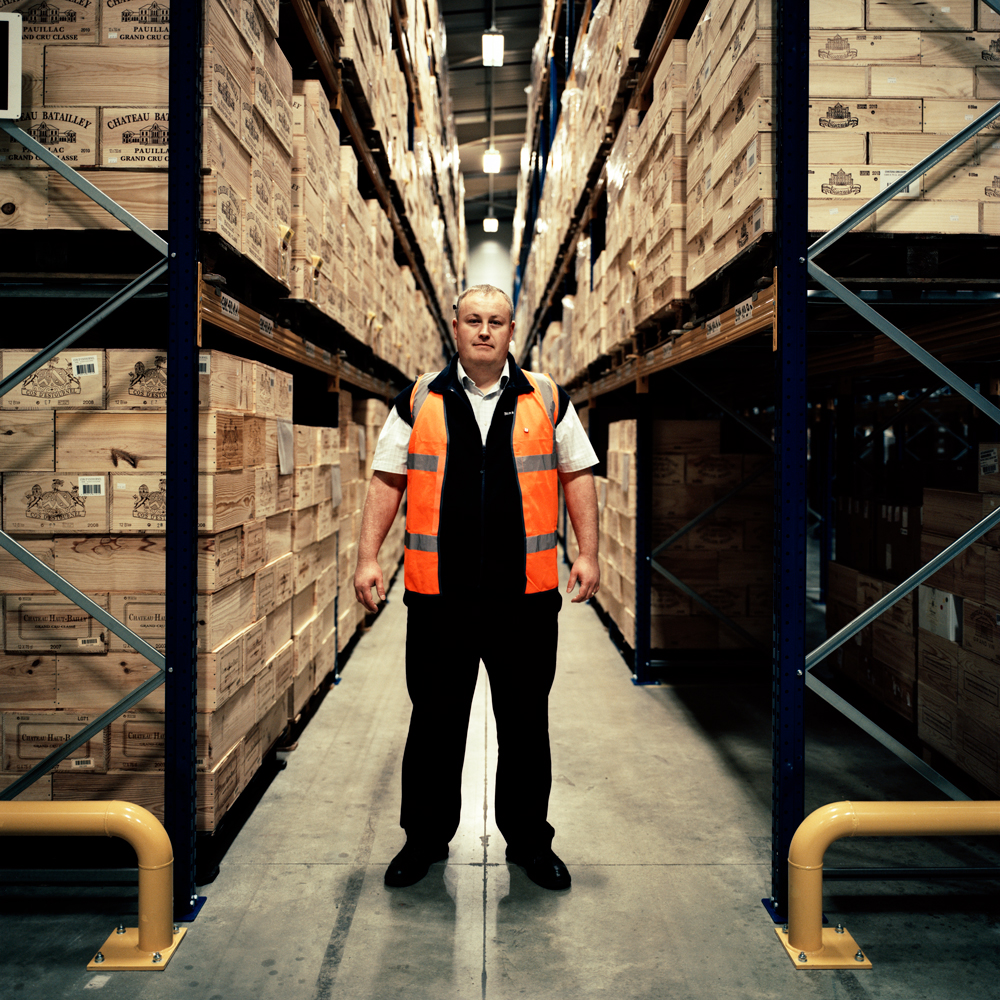The Guardian: Introducing Chris Layland
Author: Sophie Thorpe

Watching over nine million bottles, Chris Layland is the gatekeeper of the world’s most enviable wine collection. Here, Sophie Thorpe talks to him about his team, the most remarkable bottles in his care, and keeping life at 12°C
You’ll find our warehouses on an edge-of-town industrial estate in Basingstoke. Next to Topps Tiles, Greggs and KwikFit, these unassuming low-rise buildings wouldn’t merit a second glance should you drive past. But step inside the doors and it’s a different matter.
For anyone with even a passing interest in wine, the sight of vertiginous stacks of cases containing nine million bottles of the world’s finest wine is dizzying. A large portion of this £800 million treasure trove of wine isn’t owned by Berry Bros. & Rudd at all. Instead, it belongs to our customers, and is stored until it’s ready to drink, or sell.
But bottles don’t merely lie here gathering dust – the warehouse team handles around 5,000 orders each week, picking and packing everything from Good Ordinary Claret to 1945 Ch. Lafite Rothschild. Not to mention the arrival of new wines, too.
The man in charge
One man runs the show: our Head of Warehouse Operations, Chris Layland. A gregarious character, Chris has headed up our warehousing for more than 12 years, drawn by what he deems a “sexy” product. It was, he explains, a welcome change from a stint at a newspaper company (“Today’s newspaper is tomorrow’s chip paper,” Chris laments), as well as time at Bacardi and Martini.
Much has changed since Chris took the helm – under his eye, there’s been a huge expansion in warehouse space. One catalyst was the hugely successful 2005 Bordeaux vintage; it attracted unprecedented interest from the Chinese market, and a huge amount of stock was purchased. The physical wine began arriving just as Chris took up his position in 2008.
A couple of years later, BBX – our fine wine exchange – was created; the wholesale business was thriving; our new No.3 Gin had launched, and a contract to supply Virgin Atlantic Airways meant more space was needed. We opened our second warehouse, with the third following soon after in 2012.
The people
In that time, our warehouse team increased from 12 to 42 – it’s a crew that Chris is rightly proud of. “The reason I come into work is the people. One person can’t do everything, and we’ve got a really good team,” Chris explains. His rapport with his colleagues is clearly apparent as he wanders through the warehouse; there’s a healthy dose of banter, his chortle filling the cavernous space. But there’s respect too.
Mistakes can cost thousands of pounds, and so it’s essential that Chris’s eye misses nothing. Each bottle that enters our warehouse will pass through six pairs of hands before it re-emerges – six opportunities for something to go wrong.
Chris is rightfully proud of the team’s skill in handling such precious stock. To ensure every bottle maintains its value, whether for resale or consumption, each warehouse is kept at a steady temperature of 12°C, controlled to within a degree, while humidity is a constant 65%. Movement is minimal. The number of people in the warehouse is strictly controlled; security is incredibly tight.
But it’s the team’s attention to detail that really counts. Many of the crew have their Wine and Spirits Education Trust (WSET) Level 2 qualification, so they have a good grounding in the product they’re handling.
Bottled history
For any wine-lover, a look around our warehouses is an awe-inspiring experience – with a roll-call of the most illustrious vintages and finest wine producers around the world. The oldest bottle in Basingstoke is an 1845 Bual Madeira from Cossart Gordon, but it’s far from the most valuable. One of the most treasured bottles is a 1918 Ch. Mouton Rothschild: sliding it gently from its place in the rack, Chris cradles the wine – harvested in the midst of the First World War, and one of the most commonly faked bottles.
“Look at all the little imperfections,” he practically coos with admiration at the handblown glass. “You can’t fake that. Over 100 years old… and look at that level!” For contrast, he digs out a trio of bottles from a case that was – until recently – stored elsewhere.
“Rubbish,” he says, shaking his head at the varying levels of each one, “Such a shame.” Stock like this, that doesn’t meet the Berry Bros. & Rudd standard, is earmarked, to make sure that it can’t be sold on BBX, as we can’t guarantee it.
The beasts
Returning the bottles to their rightful home, Chris pauses, then grins. “Do you want to see the beasts?” We wind up and down a series of aisles, strolling past cases of Domaine de la Romanée-Conti, Petrus, Henschke, Harlan and more, until we arrive at our destination. Shifting a box to one side, Chris eases open another.
“If you want to have a party…” he steps to one side, revealing the biggest bottle of wine I’ve ever seen – a goliath, that’s 27 litres, of 2008 Torbreck’s Descendant. “Because of the size, these are all handblown. If they get it wrong, the glass will be too thin and weak in places; we’ve had that issue with a couple of them,” Chris says.
As we wander round, looking at some of the remarkable bottles that he watches over, I comment that one could easily spend hours just looking at things. “Yeah, you could,” Chris winks at me, “… but it’d be even better with a corkscrew.”


